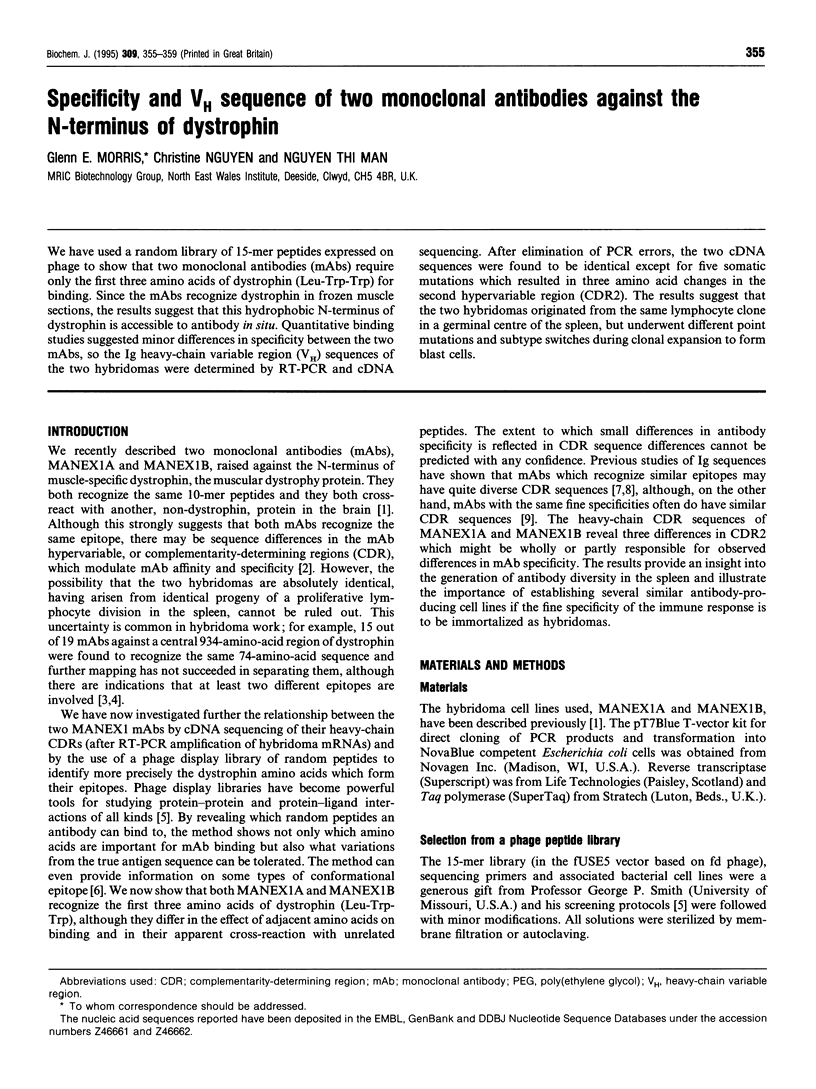Abstract
We have used a random library of 15-mer peptides expressed on phage to show that two monoclonal antibodies (mAbs) require only the first three amino acids of dystrophin (Leu-Trp-Trp) for binding. Since the mAbs recognize dystrophin in frozen muscle sections, the results suggest that this hydrophobic N-terminus of dystrophin is accessible to antibody in situ. Quantitative binding studies suggested minor differences in specificity between the two mAbs, so the Ig heavy-chain variable region (VH) sequences of the two hybridomas were determined by RT-PCR and cDNA sequencing. After elimination of PCR errors, the two cDNA sequences were found to be identical except for five somatic mutations which resulted in three amino acid changes in the second hypervariable region (CDR2). The results suggest that the two hybridomas originated from the same lymphocyte clone in a germinal centre of the spleen, but underwent different point mutations and subtype switches during clonal expansion to form blast cells.
Full text
PDF




Selected References
These references are in PubMed. This may not be the complete list of references from this article.
- Andria M. L., Levy S., Benjamini E. Diverse VH and VL genes are used to produce antibodies against a defined protein epitope. J Immunol. 1990 Apr 1;144(7):2614–2619. [PubMed] [Google Scholar]
- Balass M., Heldman Y., Cabilly S., Givol D., Katchalski-Katzir E., Fuchs S. Identification of a hexapeptide that mimics a conformation-dependent binding site of acetylcholine receptor by use of a phage-epitope library. Proc Natl Acad Sci U S A. 1993 Nov 15;90(22):10638–10642. doi: 10.1073/pnas.90.22.10638. [DOI] [PMC free article] [PubMed] [Google Scholar]
- Brodeur P. H., Riblet R. The immunoglobulin heavy chain variable region (Igh-V) locus in the mouse. I. One hundred Igh-V genes comprise seven families of homologous genes. Eur J Immunol. 1984 Oct;14(10):922–930. doi: 10.1002/eji.1830141012. [DOI] [PubMed] [Google Scholar]
- Clark E. A., Ledbetter J. A. How B and T cells talk to each other. Nature. 1994 Feb 3;367(6462):425–428. doi: 10.1038/367425a0. [DOI] [PubMed] [Google Scholar]
- Clarke S. H., Staudt L. M., Kavaler J., Schwartz D., Gerhard W. U., Weigert M. G. V region gene usage and somatic mutation in the primary and secondary responses to influenza virus hemagglutinin. J Immunol. 1990 Apr 1;144(7):2795–2801. [PubMed] [Google Scholar]
- Kavaler J., Caton A. J., Staudt L. M., Schwartz D., Gerhard W. A set of closely related antibodies dominates the primary antibody response to the antigenic site CB of the A/PR/8/34 influenza virus hemagglutinin. J Immunol. 1990 Oct 1;145(7):2312–2321. [PubMed] [Google Scholar]
- Le T. T., Nguyen T. M., Love D. R., Helliwell T. R., Davies K. E., Morris G. E. Monoclonal antibodies against the muscle-specific N-terminus of dystrophin: characterization of dystrophin in a muscular dystrophy patient with a frameshift deletion of exons 3-7. Am J Hum Genet. 1993 Jul;53(1):131–139. [PMC free article] [PubMed] [Google Scholar]
- Man N., Cartwright A. J., Andrews K. M., Morris G. E. Treatment of human muscle creatine kinase with glutaraldehyde preferentially increases the immunogenicity of the native conformation and permits production of high-affinity monoclonal antibodies which recognize two distinct surface epitopes. J Immunol Methods. 1989 Dec 20;125(1-2):251–259. doi: 10.1016/0022-1759(89)90100-2. [DOI] [PubMed] [Google Scholar]
- Nguyen T. M., Ellis J. M., Love D. R., Davies K. E., Gatter K. C., Dickson G., Morris G. E. Localization of the DMDL gene-encoded dystrophin-related protein using a panel of nineteen monoclonal antibodies: presence at neuromuscular junctions, in the sarcolemma of dystrophic skeletal muscle, in vascular and other smooth muscles, and in proliferating brain cell lines. J Cell Biol. 1991 Dec;115(6):1695–1700. doi: 10.1083/jcb.115.6.1695. [DOI] [PMC free article] [PubMed] [Google Scholar]
- Nguyen T. M., Ginjaar I. B., van Ommen G. J., Morris G. E. Monoclonal antibodies for dystrophin analysis. Epitope mapping and improved binding to SDS-treated muscle sections. Biochem J. 1992 Dec 1;288(Pt 2):663–668. doi: 10.1042/bj2880663. [DOI] [PMC free article] [PubMed] [Google Scholar]
- Nguyen T. M., Morris G. E. Use of epitope libraries to identify exon-specific monoclonal antibodies for characterization of altered dystrophins in muscular dystrophy. Am J Hum Genet. 1993 Jun;52(6):1057–1066. [PMC free article] [PubMed] [Google Scholar]
- Orlandi R., Güssow D. H., Jones P. T., Winter G. Cloning immunoglobulin variable domains for expression by the polymerase chain reaction. Proc Natl Acad Sci U S A. 1989 May;86(10):3833–3837. doi: 10.1073/pnas.86.10.3833. [DOI] [PMC free article] [PubMed] [Google Scholar]
- Padlan E. A. Anatomy of the antibody molecule. Mol Immunol. 1994 Feb;31(3):169–217. doi: 10.1016/0161-5890(94)90001-9. [DOI] [PubMed] [Google Scholar]
- Sawada J., Yamazaki T., Terao T. Molecular and biochemical analyses of combining sites of monoclonal anti-morphine antibodies. Mol Immunol. 1993 Jan;30(1):77–86. doi: 10.1016/0161-5890(93)90428-e. [DOI] [PubMed] [Google Scholar]
- Scott J. K., Smith G. P. Searching for peptide ligands with an epitope library. Science. 1990 Jul 27;249(4967):386–390. doi: 10.1126/science.1696028. [DOI] [PubMed] [Google Scholar]
- Sedgwick S. G., Nguyen T. M., Ellis J. M., Crowne H., Morris G. E. Rapid mapping by transposon mutagenesis of epitopes on the muscular dystrophy protein, dystrophin. Nucleic Acids Res. 1991 Nov 11;19(21):5889–5894. doi: 10.1093/nar/19.21.5889. [DOI] [PMC free article] [PubMed] [Google Scholar]
- Stark S. E., Caton A. J. Antibodies that are specific for a single amino acid interchange in a protein epitope use structurally distinct variable regions. J Exp Med. 1991 Sep 1;174(3):613–624. doi: 10.1084/jem.174.3.613. [DOI] [PMC free article] [PubMed] [Google Scholar]
- Stewart A. K., Schwartz R. S. Immunoglobulin V regions and the B cell. Blood. 1994 Apr 1;83(7):1717–1730. [PubMed] [Google Scholar]


